MBA641 - Strategic Project Management: PHL Website Redevelopment SOW
VerifiedAdded on 2022/10/11
|5
|2375
|16
Project
AI Summary
This Statement of Work (SOW) outlines the project to redevelop the website for PHL Pashendale Holdings Ltd (PHL), an Australian construction company. The project aims to enhance marketing and customer service through a new website rich in content, including new building developments, client testimonials, company news, and an affiliate network platform. The SOW details the project scope, including the planning, design, testing, and implementation phases, as well as the work requirements, schedule, milestones, pricing, and acceptance criteria. The project seeks to overcome the limitations of the current website, such as the lack of a cloud system for data storage and an effective customer feedback mechanism. The deliverables include internal aspects like documenting company operations and tracking resources, and external aspects like prioritizing customer needs. The project's success is measured by how well the new website meets the company's strategic objectives and achieves a competitive advantage in the market. The SOW also defines the acceptance criteria, involving the PHL's Chief Marketing Officer (CMO) and other advisors, and provides a detailed schedule, cost breakdown, and references used in the project.
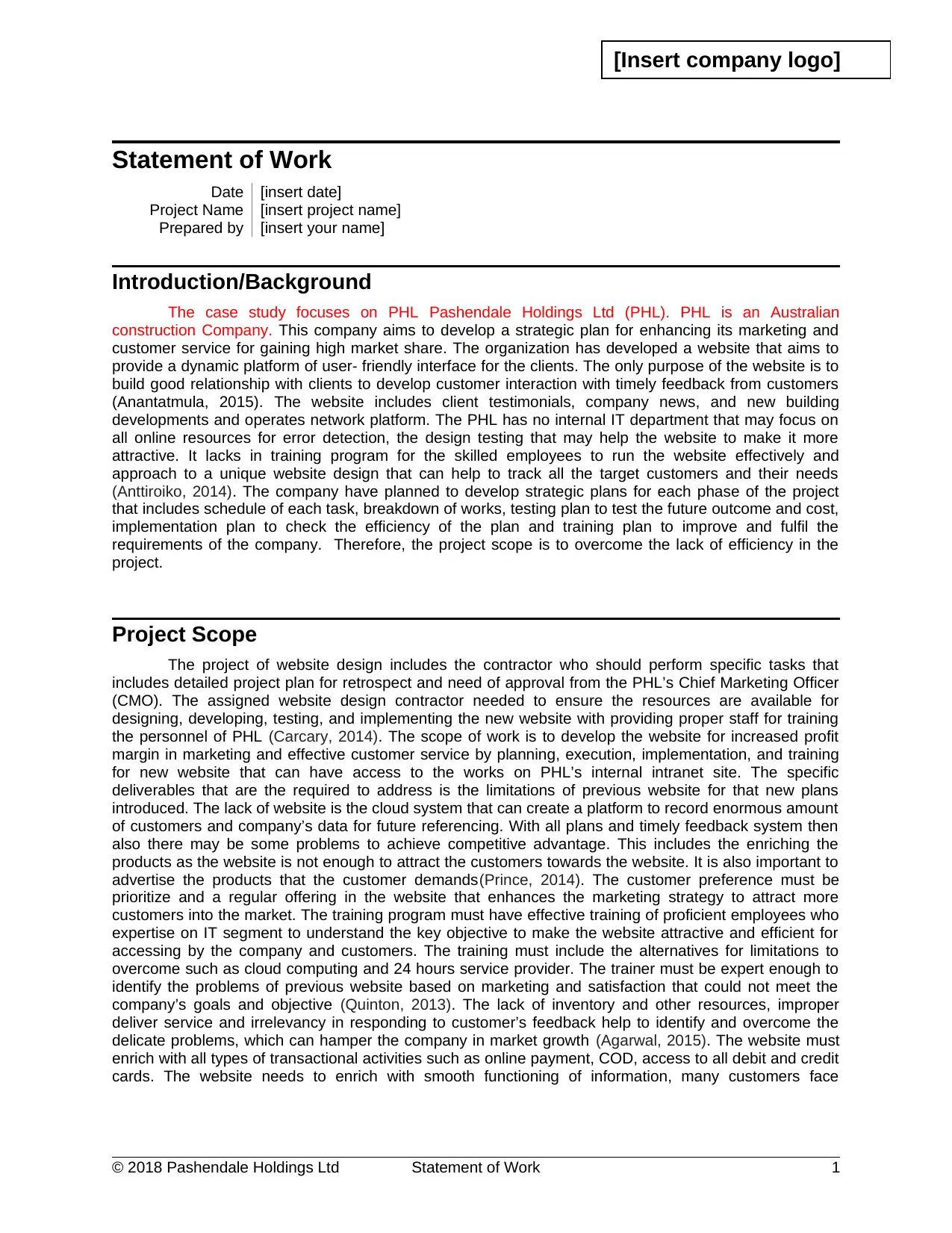
Statement of Work
Date [insert date]
Project Name [insert project name]
Prepared by [insert your name]
Introduction/Background
The case study focuses on PHL Pashendale Holdings Ltd (PHL). PHL is an Australian
construction Company. This company aims to develop a strategic plan for enhancing its marketing and
customer service for gaining high market share. The organization has developed a website that aims to
provide a dynamic platform of user- friendly interface for the clients. The only purpose of the website is to
build good relationship with clients to develop customer interaction with timely feedback from customers
(Anantatmula, 2015). The website includes client testimonials, company news, and new building
developments and operates network platform. The PHL has no internal IT department that may focus on
all online resources for error detection, the design testing that may help the website to make it more
attractive. It lacks in training program for the skilled employees to run the website effectively and
approach to a unique website design that can help to track all the target customers and their needs
(Anttiroiko, 2014). The company have planned to develop strategic plans for each phase of the project
that includes schedule of each task, breakdown of works, testing plan to test the future outcome and cost,
implementation plan to check the efficiency of the plan and training plan to improve and fulfil the
requirements of the company. Therefore, the project scope is to overcome the lack of efficiency in the
project.
Project Scope
The project of website design includes the contractor who should perform specific tasks that
includes detailed project plan for retrospect and need of approval from the PHL’s Chief Marketing Officer
(CMO). The assigned website design contractor needed to ensure the resources are available for
designing, developing, testing, and implementing the new website with providing proper staff for training
the personnel of PHL (Carcary, 2014). The scope of work is to develop the website for increased profit
margin in marketing and effective customer service by planning, execution, implementation, and training
for new website that can have access to the works on PHL’s internal intranet site. The specific
deliverables that are the required to address is the limitations of previous website for that new plans
introduced. The lack of website is the cloud system that can create a platform to record enormous amount
of customers and company’s data for future referencing. With all plans and timely feedback system then
also there may be some problems to achieve competitive advantage. This includes the enriching the
products as the website is not enough to attract the customers towards the website. It is also important to
advertise the products that the customer demands(Prince, 2014). The customer preference must be
prioritize and a regular offering in the website that enhances the marketing strategy to attract more
customers into the market. The training program must have effective training of proficient employees who
expertise on IT segment to understand the key objective to make the website attractive and efficient for
accessing by the company and customers. The training must include the alternatives for limitations to
overcome such as cloud computing and 24 hours service provider. The trainer must be expert enough to
identify the problems of previous website based on marketing and satisfaction that could not meet the
company’s goals and objective (Quinton, 2013). The lack of inventory and other resources, improper
deliver service and irrelevancy in responding to customer’s feedback help to identify and overcome the
delicate problems, which can hamper the company in market growth (Agarwal, 2015). The website must
enrich with all types of transactional activities such as online payment, COD, access to all debit and credit
cards. The website needs to enrich with smooth functioning of information, many customers face
© 2018 Pashendale Holdings Ltd Statement of Work 1
[Insert company logo]
Date [insert date]
Project Name [insert project name]
Prepared by [insert your name]
Introduction/Background
The case study focuses on PHL Pashendale Holdings Ltd (PHL). PHL is an Australian
construction Company. This company aims to develop a strategic plan for enhancing its marketing and
customer service for gaining high market share. The organization has developed a website that aims to
provide a dynamic platform of user- friendly interface for the clients. The only purpose of the website is to
build good relationship with clients to develop customer interaction with timely feedback from customers
(Anantatmula, 2015). The website includes client testimonials, company news, and new building
developments and operates network platform. The PHL has no internal IT department that may focus on
all online resources for error detection, the design testing that may help the website to make it more
attractive. It lacks in training program for the skilled employees to run the website effectively and
approach to a unique website design that can help to track all the target customers and their needs
(Anttiroiko, 2014). The company have planned to develop strategic plans for each phase of the project
that includes schedule of each task, breakdown of works, testing plan to test the future outcome and cost,
implementation plan to check the efficiency of the plan and training plan to improve and fulfil the
requirements of the company. Therefore, the project scope is to overcome the lack of efficiency in the
project.
Project Scope
The project of website design includes the contractor who should perform specific tasks that
includes detailed project plan for retrospect and need of approval from the PHL’s Chief Marketing Officer
(CMO). The assigned website design contractor needed to ensure the resources are available for
designing, developing, testing, and implementing the new website with providing proper staff for training
the personnel of PHL (Carcary, 2014). The scope of work is to develop the website for increased profit
margin in marketing and effective customer service by planning, execution, implementation, and training
for new website that can have access to the works on PHL’s internal intranet site. The specific
deliverables that are the required to address is the limitations of previous website for that new plans
introduced. The lack of website is the cloud system that can create a platform to record enormous amount
of customers and company’s data for future referencing. With all plans and timely feedback system then
also there may be some problems to achieve competitive advantage. This includes the enriching the
products as the website is not enough to attract the customers towards the website. It is also important to
advertise the products that the customer demands(Prince, 2014). The customer preference must be
prioritize and a regular offering in the website that enhances the marketing strategy to attract more
customers into the market. The training program must have effective training of proficient employees who
expertise on IT segment to understand the key objective to make the website attractive and efficient for
accessing by the company and customers. The training must include the alternatives for limitations to
overcome such as cloud computing and 24 hours service provider. The trainer must be expert enough to
identify the problems of previous website based on marketing and satisfaction that could not meet the
company’s goals and objective (Quinton, 2013). The lack of inventory and other resources, improper
deliver service and irrelevancy in responding to customer’s feedback help to identify and overcome the
delicate problems, which can hamper the company in market growth (Agarwal, 2015). The website must
enrich with all types of transactional activities such as online payment, COD, access to all debit and credit
cards. The website needs to enrich with smooth functioning of information, many customers face
© 2018 Pashendale Holdings Ltd Statement of Work 1
[Insert company logo]
Secure Best Marks with AI Grader
Need help grading? Try our AI Grader for instant feedback on your assignments.
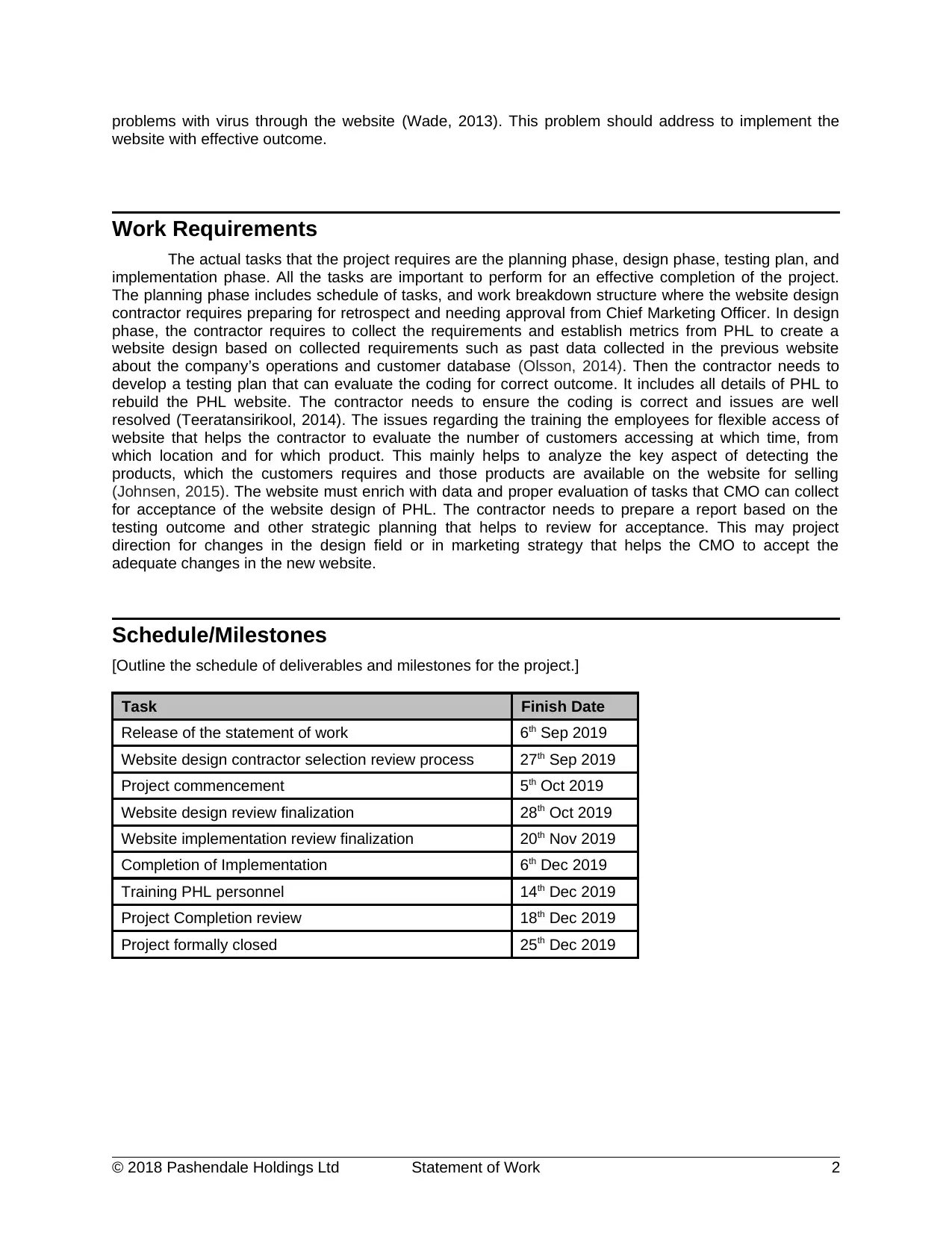
problems with virus through the website (Wade, 2013). This problem should address to implement the
website with effective outcome.
Work Requirements
The actual tasks that the project requires are the planning phase, design phase, testing plan, and
implementation phase. All the tasks are important to perform for an effective completion of the project.
The planning phase includes schedule of tasks, and work breakdown structure where the website design
contractor requires preparing for retrospect and needing approval from Chief Marketing Officer. In design
phase, the contractor requires to collect the requirements and establish metrics from PHL to create a
website design based on collected requirements such as past data collected in the previous website
about the company’s operations and customer database (Olsson, 2014). Then the contractor needs to
develop a testing plan that can evaluate the coding for correct outcome. It includes all details of PHL to
rebuild the PHL website. The contractor needs to ensure the coding is correct and issues are well
resolved (Teeratansirikool, 2014). The issues regarding the training the employees for flexible access of
website that helps the contractor to evaluate the number of customers accessing at which time, from
which location and for which product. This mainly helps to analyze the key aspect of detecting the
products, which the customers requires and those products are available on the website for selling
(Johnsen, 2015). The website must enrich with data and proper evaluation of tasks that CMO can collect
for acceptance of the website design of PHL. The contractor needs to prepare a report based on the
testing outcome and other strategic planning that helps to review for acceptance. This may project
direction for changes in the design field or in marketing strategy that helps the CMO to accept the
adequate changes in the new website.
Schedule/Milestones
[Outline the schedule of deliverables and milestones for the project.]
Task Finish Date
Release of the statement of work 6th Sep 2019
Website design contractor selection review process 27th Sep 2019
Project commencement 5th Oct 2019
Website design review finalization 28th Oct 2019
Website implementation review finalization 20th Nov 2019
Completion of Implementation 6th Dec 2019
Training PHL personnel 14th Dec 2019
Project Completion review 18th Dec 2019
Project formally closed 25th Dec 2019
© 2018 Pashendale Holdings Ltd Statement of Work 2
website with effective outcome.
Work Requirements
The actual tasks that the project requires are the planning phase, design phase, testing plan, and
implementation phase. All the tasks are important to perform for an effective completion of the project.
The planning phase includes schedule of tasks, and work breakdown structure where the website design
contractor requires preparing for retrospect and needing approval from Chief Marketing Officer. In design
phase, the contractor requires to collect the requirements and establish metrics from PHL to create a
website design based on collected requirements such as past data collected in the previous website
about the company’s operations and customer database (Olsson, 2014). Then the contractor needs to
develop a testing plan that can evaluate the coding for correct outcome. It includes all details of PHL to
rebuild the PHL website. The contractor needs to ensure the coding is correct and issues are well
resolved (Teeratansirikool, 2014). The issues regarding the training the employees for flexible access of
website that helps the contractor to evaluate the number of customers accessing at which time, from
which location and for which product. This mainly helps to analyze the key aspect of detecting the
products, which the customers requires and those products are available on the website for selling
(Johnsen, 2015). The website must enrich with data and proper evaluation of tasks that CMO can collect
for acceptance of the website design of PHL. The contractor needs to prepare a report based on the
testing outcome and other strategic planning that helps to review for acceptance. This may project
direction for changes in the design field or in marketing strategy that helps the CMO to accept the
adequate changes in the new website.
Schedule/Milestones
[Outline the schedule of deliverables and milestones for the project.]
Task Finish Date
Release of the statement of work 6th Sep 2019
Website design contractor selection review process 27th Sep 2019
Project commencement 5th Oct 2019
Website design review finalization 28th Oct 2019
Website implementation review finalization 20th Nov 2019
Completion of Implementation 6th Dec 2019
Training PHL personnel 14th Dec 2019
Project Completion review 18th Dec 2019
Project formally closed 25th Dec 2019
© 2018 Pashendale Holdings Ltd Statement of Work 2
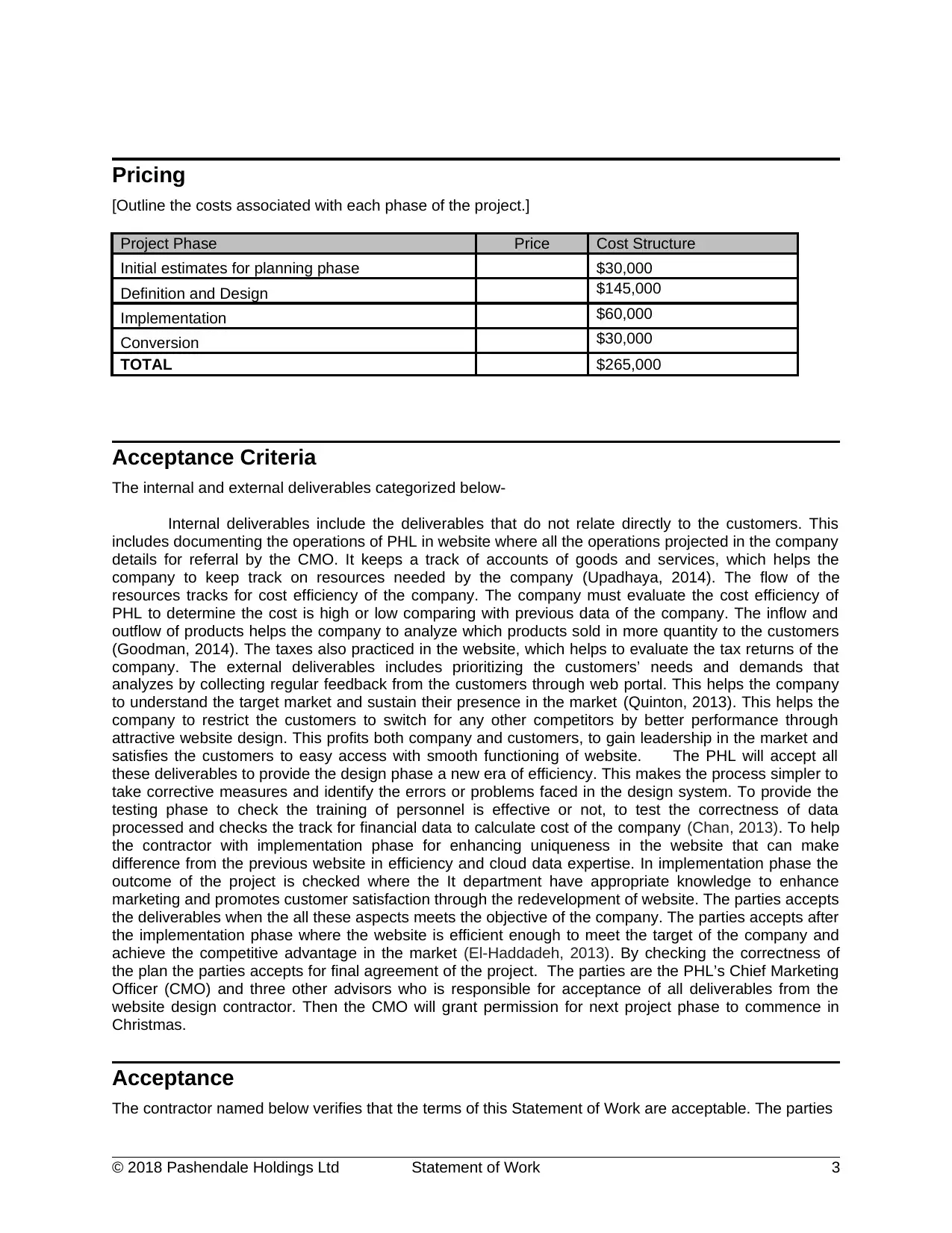
Pricing
[Outline the costs associated with each phase of the project.]
Project Phase Price Cost Structure
Initial estimates for planning phase $30,000
Definition and Design $145,000
Implementation $60,000
Conversion $30,000
TOTAL $265,000
Acceptance Criteria
The internal and external deliverables categorized below-
Internal deliverables include the deliverables that do not relate directly to the customers. This
includes documenting the operations of PHL in website where all the operations projected in the company
details for referral by the CMO. It keeps a track of accounts of goods and services, which helps the
company to keep track on resources needed by the company (Upadhaya, 2014). The flow of the
resources tracks for cost efficiency of the company. The company must evaluate the cost efficiency of
PHL to determine the cost is high or low comparing with previous data of the company. The inflow and
outflow of products helps the company to analyze which products sold in more quantity to the customers
(Goodman, 2014). The taxes also practiced in the website, which helps to evaluate the tax returns of the
company. The external deliverables includes prioritizing the customers’ needs and demands that
analyzes by collecting regular feedback from the customers through web portal. This helps the company
to understand the target market and sustain their presence in the market (Quinton, 2013). This helps the
company to restrict the customers to switch for any other competitors by better performance through
attractive website design. This profits both company and customers, to gain leadership in the market and
satisfies the customers to easy access with smooth functioning of website. The PHL will accept all
these deliverables to provide the design phase a new era of efficiency. This makes the process simpler to
take corrective measures and identify the errors or problems faced in the design system. To provide the
testing phase to check the training of personnel is effective or not, to test the correctness of data
processed and checks the track for financial data to calculate cost of the company (Chan, 2013). To help
the contractor with implementation phase for enhancing uniqueness in the website that can make
difference from the previous website in efficiency and cloud data expertise. In implementation phase the
outcome of the project is checked where the It department have appropriate knowledge to enhance
marketing and promotes customer satisfaction through the redevelopment of website. The parties accepts
the deliverables when the all these aspects meets the objective of the company. The parties accepts after
the implementation phase where the website is efficient enough to meet the target of the company and
achieve the competitive advantage in the market (El-Haddadeh, 2013). By checking the correctness of
the plan the parties accepts for final agreement of the project. The parties are the PHL’s Chief Marketing
Officer (CMO) and three other advisors who is responsible for acceptance of all deliverables from the
website design contractor. Then the CMO will grant permission for next project phase to commence in
Christmas.
Acceptance
The contractor named below verifies that the terms of this Statement of Work are acceptable. The parties
© 2018 Pashendale Holdings Ltd Statement of Work 3
[Outline the costs associated with each phase of the project.]
Project Phase Price Cost Structure
Initial estimates for planning phase $30,000
Definition and Design $145,000
Implementation $60,000
Conversion $30,000
TOTAL $265,000
Acceptance Criteria
The internal and external deliverables categorized below-
Internal deliverables include the deliverables that do not relate directly to the customers. This
includes documenting the operations of PHL in website where all the operations projected in the company
details for referral by the CMO. It keeps a track of accounts of goods and services, which helps the
company to keep track on resources needed by the company (Upadhaya, 2014). The flow of the
resources tracks for cost efficiency of the company. The company must evaluate the cost efficiency of
PHL to determine the cost is high or low comparing with previous data of the company. The inflow and
outflow of products helps the company to analyze which products sold in more quantity to the customers
(Goodman, 2014). The taxes also practiced in the website, which helps to evaluate the tax returns of the
company. The external deliverables includes prioritizing the customers’ needs and demands that
analyzes by collecting regular feedback from the customers through web portal. This helps the company
to understand the target market and sustain their presence in the market (Quinton, 2013). This helps the
company to restrict the customers to switch for any other competitors by better performance through
attractive website design. This profits both company and customers, to gain leadership in the market and
satisfies the customers to easy access with smooth functioning of website. The PHL will accept all
these deliverables to provide the design phase a new era of efficiency. This makes the process simpler to
take corrective measures and identify the errors or problems faced in the design system. To provide the
testing phase to check the training of personnel is effective or not, to test the correctness of data
processed and checks the track for financial data to calculate cost of the company (Chan, 2013). To help
the contractor with implementation phase for enhancing uniqueness in the website that can make
difference from the previous website in efficiency and cloud data expertise. In implementation phase the
outcome of the project is checked where the It department have appropriate knowledge to enhance
marketing and promotes customer satisfaction through the redevelopment of website. The parties accepts
the deliverables when the all these aspects meets the objective of the company. The parties accepts after
the implementation phase where the website is efficient enough to meet the target of the company and
achieve the competitive advantage in the market (El-Haddadeh, 2013). By checking the correctness of
the plan the parties accepts for final agreement of the project. The parties are the PHL’s Chief Marketing
Officer (CMO) and three other advisors who is responsible for acceptance of all deliverables from the
website design contractor. Then the CMO will grant permission for next project phase to commence in
Christmas.
Acceptance
The contractor named below verifies that the terms of this Statement of Work are acceptable. The parties
© 2018 Pashendale Holdings Ltd Statement of Work 3
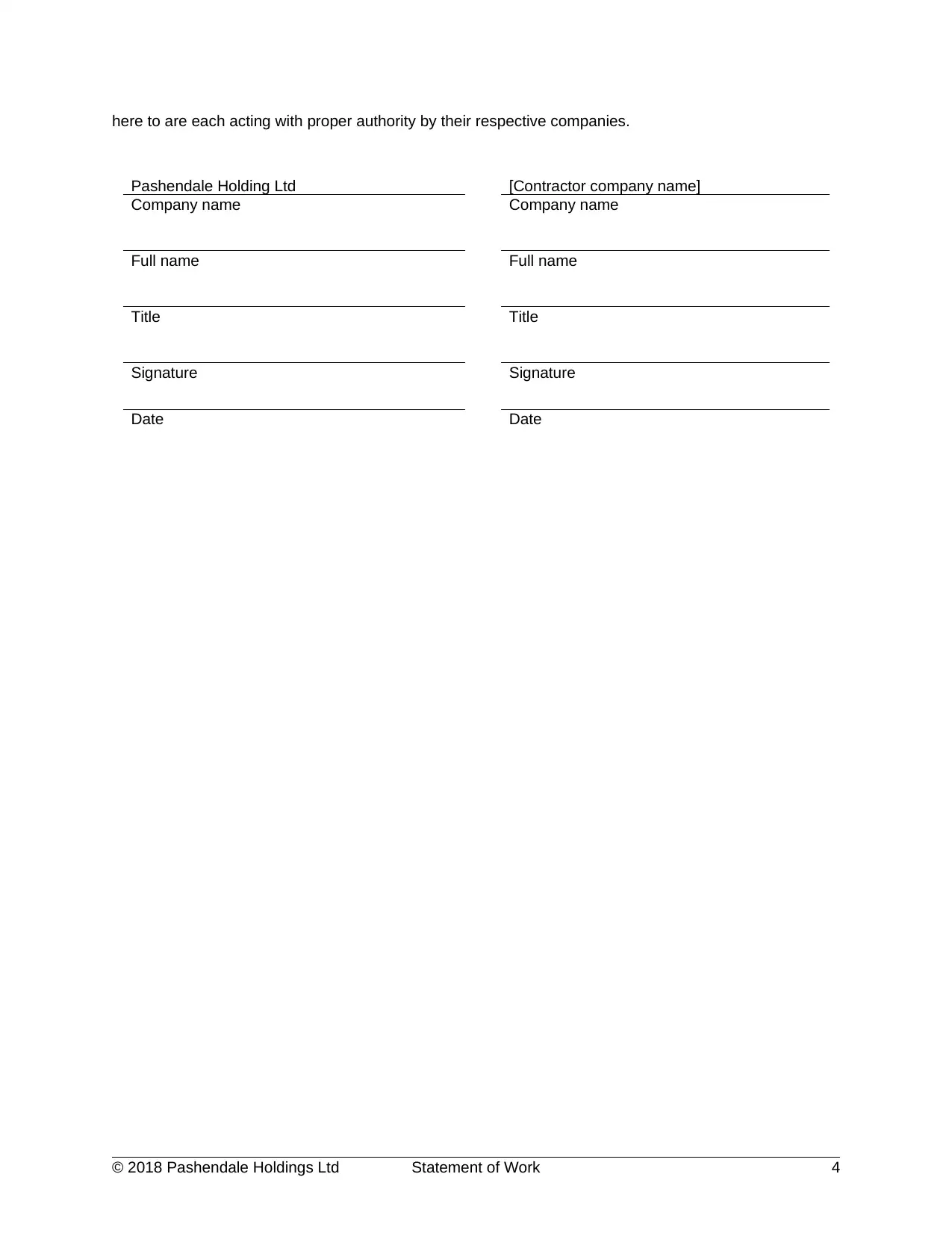
here to are each acting with proper authority by their respective companies.
Pashendale Holding Ltd [Contractor company name]
Company name Company name
Full name Full name
Title Title
Signature Signature
Date Date
© 2018 Pashendale Holdings Ltd Statement of Work 4
Pashendale Holding Ltd [Contractor company name]
Company name Company name
Full name Full name
Title Title
Signature Signature
Date Date
© 2018 Pashendale Holdings Ltd Statement of Work 4
Secure Best Marks with AI Grader
Need help grading? Try our AI Grader for instant feedback on your assignments.
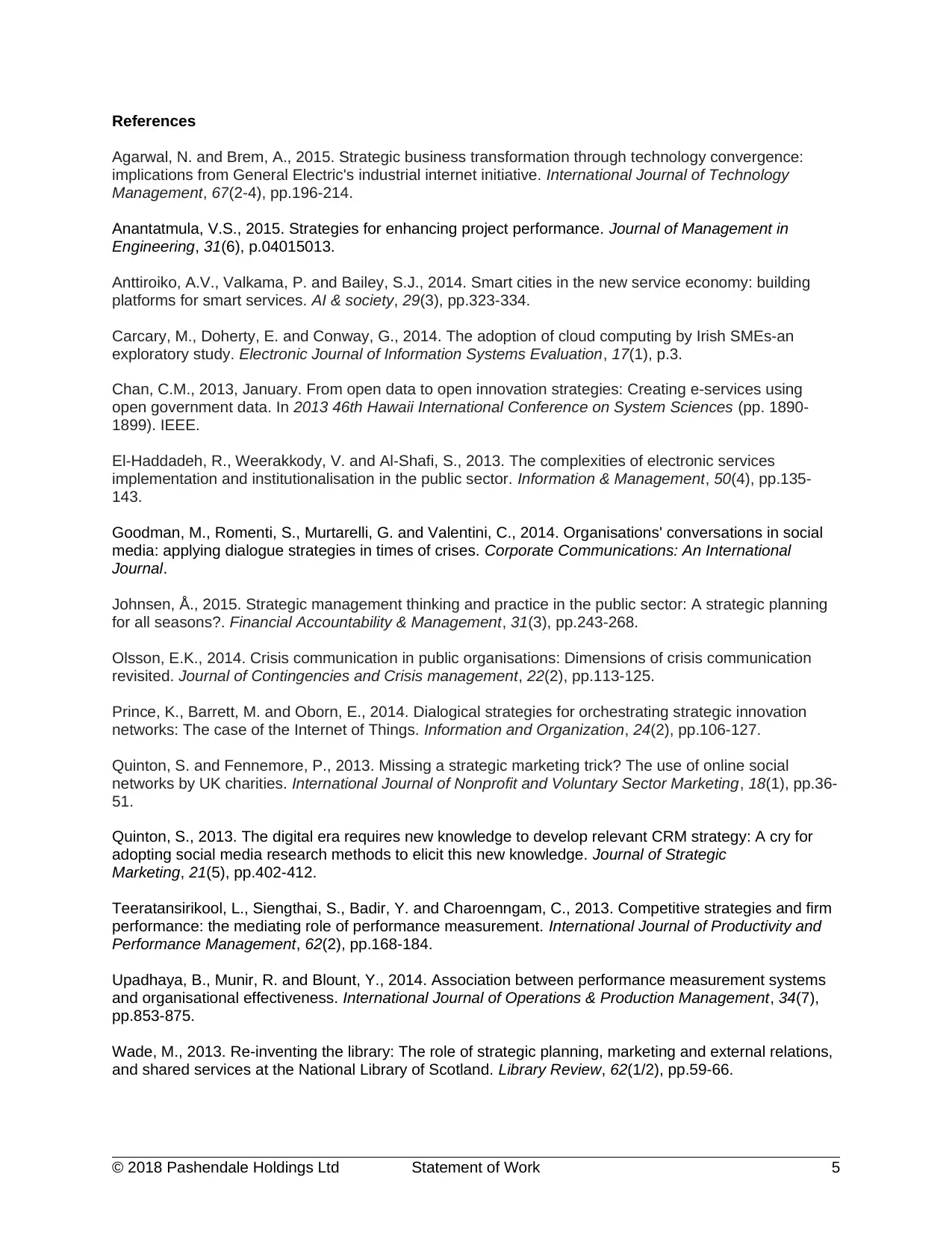
References
Agarwal, N. and Brem, A., 2015. Strategic business transformation through technology convergence:
implications from General Electric's industrial internet initiative. International Journal of Technology
Management, 67(2-4), pp.196-214.
Anantatmula, V.S., 2015. Strategies for enhancing project performance. Journal of Management in
Engineering, 31(6), p.04015013.
Anttiroiko, A.V., Valkama, P. and Bailey, S.J., 2014. Smart cities in the new service economy: building
platforms for smart services. AI & society, 29(3), pp.323-334.
Carcary, M., Doherty, E. and Conway, G., 2014. The adoption of cloud computing by Irish SMEs-an
exploratory study. Electronic Journal of Information Systems Evaluation, 17(1), p.3.
Chan, C.M., 2013, January. From open data to open innovation strategies: Creating e-services using
open government data. In 2013 46th Hawaii International Conference on System Sciences (pp. 1890-
1899). IEEE.
El-Haddadeh, R., Weerakkody, V. and Al-Shafi, S., 2013. The complexities of electronic services
implementation and institutionalisation in the public sector. Information & Management, 50(4), pp.135-
143.
Goodman, M., Romenti, S., Murtarelli, G. and Valentini, C., 2014. Organisations' conversations in social
media: applying dialogue strategies in times of crises. Corporate Communications: An International
Journal.
Johnsen, Å., 2015. Strategic management thinking and practice in the public sector: A strategic planning
for all seasons?. Financial Accountability & Management, 31(3), pp.243-268.
Olsson, E.K., 2014. Crisis communication in public organisations: Dimensions of crisis communication
revisited. Journal of Contingencies and Crisis management, 22(2), pp.113-125.
Prince, K., Barrett, M. and Oborn, E., 2014. Dialogical strategies for orchestrating strategic innovation
networks: The case of the Internet of Things. Information and Organization, 24(2), pp.106-127.
Quinton, S. and Fennemore, P., 2013. Missing a strategic marketing trick? The use of online social
networks by UK charities. International Journal of Nonprofit and Voluntary Sector Marketing, 18(1), pp.36-
51.
Quinton, S., 2013. The digital era requires new knowledge to develop relevant CRM strategy: A cry for
adopting social media research methods to elicit this new knowledge. Journal of Strategic
Marketing, 21(5), pp.402-412.
Teeratansirikool, L., Siengthai, S., Badir, Y. and Charoenngam, C., 2013. Competitive strategies and firm
performance: the mediating role of performance measurement. International Journal of Productivity and
Performance Management, 62(2), pp.168-184.
Upadhaya, B., Munir, R. and Blount, Y., 2014. Association between performance measurement systems
and organisational effectiveness. International Journal of Operations & Production Management, 34(7),
pp.853-875.
Wade, M., 2013. Re-inventing the library: The role of strategic planning, marketing and external relations,
and shared services at the National Library of Scotland. Library Review, 62(1/2), pp.59-66.
© 2018 Pashendale Holdings Ltd Statement of Work 5
Agarwal, N. and Brem, A., 2015. Strategic business transformation through technology convergence:
implications from General Electric's industrial internet initiative. International Journal of Technology
Management, 67(2-4), pp.196-214.
Anantatmula, V.S., 2015. Strategies for enhancing project performance. Journal of Management in
Engineering, 31(6), p.04015013.
Anttiroiko, A.V., Valkama, P. and Bailey, S.J., 2014. Smart cities in the new service economy: building
platforms for smart services. AI & society, 29(3), pp.323-334.
Carcary, M., Doherty, E. and Conway, G., 2014. The adoption of cloud computing by Irish SMEs-an
exploratory study. Electronic Journal of Information Systems Evaluation, 17(1), p.3.
Chan, C.M., 2013, January. From open data to open innovation strategies: Creating e-services using
open government data. In 2013 46th Hawaii International Conference on System Sciences (pp. 1890-
1899). IEEE.
El-Haddadeh, R., Weerakkody, V. and Al-Shafi, S., 2013. The complexities of electronic services
implementation and institutionalisation in the public sector. Information & Management, 50(4), pp.135-
143.
Goodman, M., Romenti, S., Murtarelli, G. and Valentini, C., 2014. Organisations' conversations in social
media: applying dialogue strategies in times of crises. Corporate Communications: An International
Journal.
Johnsen, Å., 2015. Strategic management thinking and practice in the public sector: A strategic planning
for all seasons?. Financial Accountability & Management, 31(3), pp.243-268.
Olsson, E.K., 2014. Crisis communication in public organisations: Dimensions of crisis communication
revisited. Journal of Contingencies and Crisis management, 22(2), pp.113-125.
Prince, K., Barrett, M. and Oborn, E., 2014. Dialogical strategies for orchestrating strategic innovation
networks: The case of the Internet of Things. Information and Organization, 24(2), pp.106-127.
Quinton, S. and Fennemore, P., 2013. Missing a strategic marketing trick? The use of online social
networks by UK charities. International Journal of Nonprofit and Voluntary Sector Marketing, 18(1), pp.36-
51.
Quinton, S., 2013. The digital era requires new knowledge to develop relevant CRM strategy: A cry for
adopting social media research methods to elicit this new knowledge. Journal of Strategic
Marketing, 21(5), pp.402-412.
Teeratansirikool, L., Siengthai, S., Badir, Y. and Charoenngam, C., 2013. Competitive strategies and firm
performance: the mediating role of performance measurement. International Journal of Productivity and
Performance Management, 62(2), pp.168-184.
Upadhaya, B., Munir, R. and Blount, Y., 2014. Association between performance measurement systems
and organisational effectiveness. International Journal of Operations & Production Management, 34(7),
pp.853-875.
Wade, M., 2013. Re-inventing the library: The role of strategic planning, marketing and external relations,
and shared services at the National Library of Scotland. Library Review, 62(1/2), pp.59-66.
© 2018 Pashendale Holdings Ltd Statement of Work 5
1 out of 5
Related Documents
Your All-in-One AI-Powered Toolkit for Academic Success.
+13062052269
info@desklib.com
Available 24*7 on WhatsApp / Email
![[object Object]](/_next/static/media/star-bottom.7253800d.svg)
Unlock your academic potential
© 2024 | Zucol Services PVT LTD | All rights reserved.





